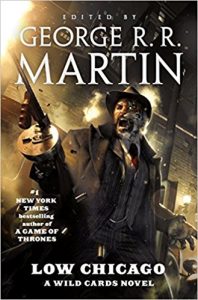Paula Guran Reviews Low Chicago Edited by George R.R. Martin & Melinda M. Snodgrass
 Low Chicago, George R.R. Martin & Melinda M. Snodgrass, eds. (Tor 978-0-7653-9056-1, $27.99, hc) June 2018.
Low Chicago, George R.R. Martin & Melinda M. Snodgrass, eds. (Tor 978-0-7653-9056-1, $27.99, hc) June 2018.
John Jos. Miller sets up the premise for this latest Wild Cards mosaic novel in the first part of “A Long Night at the Palmer House”: a high stakes poker game hosted in the present day by an elite gangster at Chicago’s historic and still luxurious Palmer House Hotel. He also introduces the players – a motley, if exotic, crew of high rollers and supporting cast. Nine subsequent “parts” provide more than links between the novelettes/novellas by seven other authors.
The seven poker players are each allowed two “attendants,” and most opt for at least one of theirs to be an Ace – an individual with unique superhuman abilities gained after surviving an alien virus – who serves as a bodyguard. A ruckus results in most of those assembled being flung into various pasts. The time stream is broken and the stability of the entire universe is at stake, with the Palmer House remaining an eye in a time storm with history continually changing around it. This gives Aces John Nighthawk and Croyd “The Sleeper” Crenson a base from which to try to find the temporarily displaced and prevent the changes their presences and actions made in the past.
The time travelers arrive in different eras, but all remain geographically in Chicago, or what would become Chicago. In “Down the Rabbit Hole” by Kevin Andrew Murphy, Hollywood hotshot Will Monroe, illegitimate son of Marilyn Monroe, lands in 1960 Chicago with Julie Cotton, a Joker who had been the poker game’s barmaid. (Jokers are virus survivors who developed freakish deformities). Hugh Hefner and Playboy are on the rise in Chitown and Julie happens to have bunny ears and a cottontail; Monroe has always wanted to meet the man he suspects was his father; and Senator John F. Kennedy is visiting the newly established Playboy Mansion. They can’t resist wanting to change the course of history.
Although revenge is the primary plot of Christopher Rowe’s “The Motherfucking Apotheosis of Todd Motherfucking Taszycki”, the story is more about a latent Ace’s construction-connected powers triggered back in in 2007. Khan – a half-man, half-Bengal tiger Ace – makes his debut in the story, and is featured more prominently in “Stripes” by Marko Kloos, where he messes with mobster murders in 1929.
In the weirdest story of the bunch, “A Bit of a Dinosaur” by Paul Cornell, an Ace finds aliens have arrived in the Late Triassic to observe a space-time anomaly.
“The Sister in the Streets” by Melinda M. Snodgrass takes place during the chaos of the 1968 Democratic Convention. A social-activist nun’s encounter with a gender-changing Ace has more depth than some of the other stories.
Brown-skinned Ace Natya deals with intriguing challenges in Mary Anne Mohanraj’s “A Beautiful Façade” when she arrives in 1893 on the eve of the opening of the Columbian Exposition. She winds up as a “hootchy-kootchy” dancer at the fair and living at a hotel run by the (soon to be notorious) H.H. Holmes. Saladin Ahmed’s “Meathooks on Ice” introduces a new Ace, Meathooks, who lands in prehistory, where he’s much admired for his size and strength.
Humor is a nice touch throughout: one arrives in the past naked and has to cope with it; mentions of the “butterfly effect,” variously attributed to several science fiction masters, are a running joke.
The stories are all solid and entertainingly deal with the various time paradoxes, but it is Miller’s linking interludes/stories that make it all work. He fills in gaps with Nighthawk and The Sleeper’s universe-saving excursions into the past, not only by providing logical participation in the others’ storylines, but with original tales – like that of Charlie Flowers, a Pete Rose-ish ex-athlete/gambler, found in 1919 trying to fix the World Series – and consequential ones. (What happens after Snodgrass’s alterations to 1968? A 1975 with Aces resisting martial law and the Purity Party.)
Miller also gives it all a nice twist and deals well with the ultimate paradoxes of time-travel stories. Do all minute changes alter everything in the universe? Are changes actually changes or are they history? Are stones thrown in the river of time merely ripples?
The only problem I have with the Wild Card universe is its overabundance of riches. Low Chicago is the 25th book in the shared-universe series. More than 40 writers have contributed since its creation in 1987. A lot of terrific Aces and Jokers have been created and are still being created. There are appearances in Low Chicago by the likes of Golden Boy (created by Walter Jon Williams in the first book, 1987), Jay and Jerry Strauss (Walton Simmons, second book, 1987), and Nick “Will O’Wisp” Williams (Williams again, 13th book, 1993); there is a major role played by The Sleeper (Roger Zelazny, first book, 1987); cameos by early characters like The Great and Powerful Turtle, Chrysalis, Squidface, and Fortunato; and mentions of now-classic characters such as Dr. Tachyon, Jetboy, and Jube the Walrus.
Meanwhile, most central characters – like Nighthawk, Abigail “The Understudy” Baker, Natya, and Double Helix – are fairly new additions, introduced since the 2002/2006 series relaunch.
Should you even try to keep track? Probably not. Low Chicago is a good entry point for those new to Wild Cards, a good read for those of us who are not immersed but have some knowledge, and another treat for true Wild Card fans.
Paula Guran has edited more than 40 science fiction, fantasy, and horror anthologies and more than 50 novels and collections featuring the same. She’s reviewed and written articles for dozens of publications. She lives in Akron, Ohio, near enough to her grandchildren to frequently be indulgent.
This review and more like it in the August 2018 issue of Locus.
 While you are here, please take a moment to support Locus with a one-time or recurring donation. We rely on reader donations to keep the magazine and site going, and would like to keep the site paywall free, but WE NEED YOUR FINANCIAL SUPPORT to continue quality coverage of the science fiction and fantasy field.
While you are here, please take a moment to support Locus with a one-time or recurring donation. We rely on reader donations to keep the magazine and site going, and would like to keep the site paywall free, but WE NEED YOUR FINANCIAL SUPPORT to continue quality coverage of the science fiction and fantasy field.








